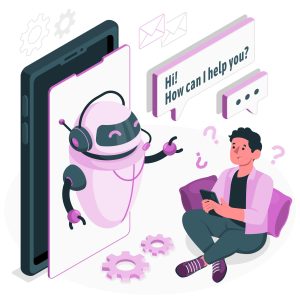The New Rage: ChatGPT

What is ChatGPT?
ChatGPT is a state-of-the-art language model created by OpenAI, which uses deep learning to generate human-like text. The model has its foundation in the GPT (Generative Pre-trained Transformer) architecture. It has been proven highly effective in natural language processing tasks.
One of the critical features of ChatGPT is its ability to generate a wide range of text, including creative writing, news articles, and even code. It achieves the said feature through pre-training, where the model undergoes training on a large text dataset before being fine-tuned for specific tasks. During pre-training, the model learns to understand language’s underlying structure and to mean, allowing it to generate coherent text.
Tasks Performed by ChatGPT
In addition to its generative capabilities, ChatGPT can perform various language understanding tasks, such as answering questions and generating summaries. This is made possible by the model’s ability to understand the underlying meaning and context of the text it is processing. For example, when given a question, the model can use its understanding of the input text to generate a relevant and accurate response.
One of the most remarkable things about ChatGPT is its ability to handle various input types- structured and unstructured data. This makes it a versatile tool for multiple applications, such as natural language processing, content generation, and customer service automation. For example, ChatGPT can undergo fine-tuning to generate product descriptions for an e-commerce website. It can also assist in customer service chatbots, answering common questions and providing helpful information.
ChatGPT has also been used in creative writing. It has been shown to generate highly coherent and creative texts, some even passing as human-made. This opens the door for new possibilities in the writing industry. ChatGPT could be used as a tool for writers, helping them with ideas, plot development, or even writing entire books.
Another example of ChatGPT’s versatility is its ability to generate code; fine-tuning the model to understand and develop code could be a valuable tool for developers and programmers, helping them with debugging and code completion and even generating entire programs.
Will ChatGPT Take Over Google with Time?

ChatGPT or any other language model will only partially take over Google or replace the search giant entirely. Google has a wide range of services and capabilities beyond just search. Google’s services include email, cloud storage, and productivity tools, that OpenAI still needs to get designed ChatGPT to provide.
Additionally, Google has a large team of engineers and researchers. They are constantly working to improve and develop their search algorithms, which have been refined over many years. The said language model maybe powerful, but it is not explicitly designed for search or needs to be fine-tuned for it specifically.
However, ChatGPT could enhance certain aspects of Google’s services, such as natural language processing in search queries or assist in developing new features. As a language model, ChatGPT can help Google to improve its search results by understanding the intent behind a user’s query and providing more relevant results.
In any case, it’s important to note that ChatGPT is a tool, and its ultimate value and impact will depend on how people use it. It is not a magic bullet that will solve all problems, and it’s essential to use it in the proper context and with the right expectations.
How Accurate is the Language Model?
ChatGPT, like all language models, could be better. Its accuracy can vary depending on the task and the data it was trained on.
ChatGPT is highly accurate in generating coherent and fluent text, as it has been pre-trained on a large dataset of text and has learned the underlying structure and meaning of language. This allows it to generate text often indistinguishable from text written by humans.
However, the accuracy of ChatGPT’s language understanding tasks, such as answering questions or generating summaries, can vary depending on the task’s complexity and specificity and the training data’s quality. For example, ChatGPT might have a higher accuracy rate when answering general questions, as it has been trained on a humoungous dataset of text and has learned a wide range of knowledge. Still, it might need help with specific or niche questions requiring specialised knowledge or expertise.
It’s also worth noting that ChatGPT, is only as accurate as the data it was trained on. Hence, if the training data is biased or of low quality, the model will likely produce biased or inaccurate results.
In conclusion, ChatGPT is a highly accurate language model for generating coherent and fluent text. Still, the accuracy of its language understanding tasks can vary depending on the task’s complexity, specificity and the training data’s quality.
The Constraints of ChatGPT
Like all language models, ChatGPT has some limitations. It is still a machine and has different understanding and reasoning capabilities than humans. Additionally, it can be prone to producing biased or nonsensical output if trained on partial data. It’s essential to remember that language models like ChatGPT are only as good as the data they are trained on. Therefore, ensuring that the training data is diverse and unbiased is crucial.
Another limitation of ChatGPT is its computational requirements. It is a large and complex model that requires a significant amount of computational power to run. Thus, making it difficult to use in some cases, such as in low-resource environments.
Still a Journey to Undertake
Despite these limitations, ChatGPT represents a significant advancement in natural language processing. It also has the potential to revolutionise a wide range of industries. With continued development and fine-tuning, ChatGPT can become an increasingly valuable tool for various sectors. It can help with tasks such as content creation, customer service, and even programming.
In conclusion, ChatGPT is a powerful language model. It can generate a wide range of text and perform various language understanding tasks. With its ability to handle myriad input types and its versatility, people can use ChatGPT in multiple applications, from creative writing to customer service automation.
-
14
+Category
-
98
+Post
Top Categories
Popular Posts
- The Power of Prototyping in Software Development
- Version Control Best Practices for App Development
- Understanding Visual Hierarchy: A Guide to Effective Design
- Crafting Intuitive Navigation: A Guide to Seamless User Experience
- Choose Your Best Cloud Provider
- Making the Leap: Transitioning from Manual to Automated Software Testing
- Using GitHub- Advantages and Disadvantages
- E-commerce Product Photography on a Budget
- Tech Innovation in Developing Countries
- Smart Cities: How Technology is Shaping the Urban Landscape
- Principles of Composition: Creating Visual Harmony with Composition
- Exploring Cross-Platform App Development
- Why Regular Website Updates Matter
- Navigating Effective Facebook Audience Targeting
- Implementing Ads for Game Monetization
- Designing User-Centric Mental Health Apps: Enhancing Well-being in the Digital Age
- NFTs and Collectibles: Creating NFT App Solutions for Collectors and Enthusiasts
- Successful Implementation of Enterprise Apps
- Maximizing Business Impact with EQ
- Proven SMO Ads Optimization Tips (2023)






